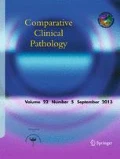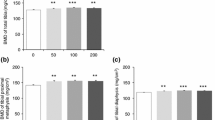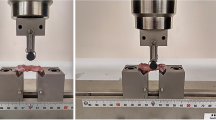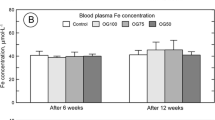Abstract
In 12 dogs, transperiosteal osteotomies of the right tibia and fibula were performed and fixed with a plate. Six dogs received orally 100 mg alpha-tocopherol acetate (Vitamin E®, Phytopharma Ltd, Troyan, Bulgaria) as a single daily dose for 30 days (PLO-E group), and the other six were not treated (PLO group). Craniocaudal radiographs were obtained immediately after the osteosynthesis, on postoperative week 2 and months 1, 2, 3, and 4. At the same intervals, venous blood was sampled for determination of serum malondialdehyde concentrations and serum catalase activities. The daily oral administration of 100 mg alpha-tocopherol to dogs for 30 days after osteotomy and plate osteosynthesis of tubular bones resulted in reduction of serum malondialdehyde concentrations after the first week and maintenance of high serum catalase activity to the end of the third month. As assessed radiologically, the beneficial effect of vitamin E supplementation was manifested by earlier bridging of the fracture line, more solid mineralization, and remodeling of bone callus.


Similar content being viewed by others
References
Andreeva LI, Kozhemyakin LA, Kishkun AA (1988) A modified thiobarbituric acid test for measuring lipid peroxidation. Lab Delo 11:41–43
Cetinus E, Kiline M, Uzel M et al (2005) Does long-term ischemia affect the oxidant status during fracture healing? Arch Orthop Trauma Surg 125(6):376–380
Cornell CN, Lane JM (1992) Newest factors in fracture healing. Clin Orthop Relat Res 277:297–311
Durak K, Bilgen OF, Kaleli T et al (1996) Antioxidant effect of alpha-tocopherol on fracture haematoma in rabbits. J Int Med Res 24(5):419–424
Durak K, Sonmez G, Sarisozen B et al (2003) Histological assessment of the effect of α-tocopherol on fracture healing in rabbits. J Int Med Res 31:26–30
Durmuş AS, Akpolat N, Ünsaldi E (2008) Effect of dl-alpha-tocopherol-acetate on the fracture healing of experimental radial diaphysis fracture in dogs. Araştirma 22:141–146
Duygulu F, Yakan B, Karauglu S et al (2007) The effect of zimosan and the protective effect of various antioxidants on fracture healing in rats. Acta Orthop Trauma Surg 127:493–501
El-Sohemy A, Baylin A, Spiegelman D et al (2002) Dietary and nadipose tissue gamma-tocopherol and risk of myocardial infarction. Epidemiology 13:216–223
Göktürk E, Turgut A, Bayçu C et al (1995) Oxygen free radicals impair fracture healing in rats. Acta Orthop Scand 66:473–475
Gonzales R, Auclair C, Voisin E et al (1984) Superoxide dismutase, catalase and glutathione peroxydase in red blood cells from patients with malignant diseases. Cancer Res 44:4137–4139
Goranov NV (2007) Serum markers of lipid peroxidation, antioxidant enzymatic defense and collagen degradation in an experimental (Pond-Nuki) canine model of osteoarthritis. Vet Clin Pathol 36:192–195
Goth L (1991) A simple method for determination of serum catalase activity and revision of reference range. Clin Chim Acta 196:143–151
Keel M, Trentz O (2005) Pathophysiology of polytrauma. Injury 36:691–709
Keskin D, Kiziltunc A (2007) Time-dependent changes in serum nitric oxide levels after long bone fracture. Tohoku J Exp Med 213:283–289
Kozlova MV, Ivanov VN, Pinelis IST et al (1997) The effect of selenium on free-radical oxidation processes in the bone regenerate after a fracture. Patol Fiziol Èksp Ter 2:35–37
Lantz GC (1995) Oxygen free radicals and reperfusion injury. Special therapy. In: Bonagura JD (ed) Kirk's current veterinary therapy XII. Small animal practice. WB Saunders Company, Philadelphia, pp 64–67
Mates JM (1999) Antioxidant enzymes and human disease. Clin Biochem 32:593–603
Norazlina M, Ima-Nirwana S, Gapor MTA (2002) Tocotrienols are needed for normal bone calcification in growing female rats. Asia Pac J Clin Nutr 11:159–164
Paskalev MD (2009) Time course of serum malondialdehyde concentrations as a marker of oxidative stress in experimental canine osteotomies fixed by two different techniques. Comp Clin Pathol 18:265–268. doi:10.1007/s00580-008-0796-1
Petrovich YA, Podorozhnaya RP, Kichenko SMT et al (2004) Effects of selenium-containing compounds and their metabolism in intact rats and in animals with bone fractures. Bul Exp Biol Med 137:74–77
Prasad G, Dhillon MS, Khullar MT et al (2003) Evaluation of oxidative stress after fractures. A preliminary study. Acta Orthop Belg 69:546–551
Reilly PM, Schiller HJ, Bulkley GB (1991) Pharmacologic approach to tissue injury mediated by free radicals and other reactive oxygen metabolites. Am J Surg 161:488–503
Sergeev IN, Kha KP, Blazheevich NV (1987) Effect of combined vitamin D and E deficiencies on calcium metabolism and bone tissue of the rats. Vopr Pitan 1:39–43
Sherman DL, Keaney JF, Biegelsen ES et al (2000) Pharmacological concentrations of ascorbic acid are required for the beneficial effect on endothelial vasomotor function in hypertension. Hypertension 35:936–941
Tasatargil A, Cadir B, Dalaklioglu S et al (2007) Effects of vitamin K1 supplementation on vascular responsiveness and oxidative stress in a rat femoral osteotomy model. Cell Biochem Funct 25:485–490
Turgut A, Gokturk E, Kose N et al (1999) Oxidant status increased during fracture healing in rats. Acta Orthop Scand 70:487–490
Turk C, Halici M, Guney A et al (2004) Promotion of fracture healing by vitamin E in rats. J Int Med Res 32:507–512
Uchiyama M, Michara M (1978) Determination of malondialdehyde precursor in tissues by thiobarbituric acid test. Biochemistry 86:271–278
Vaziri ND, Zhenmin N, Oveizzi F et al (2000) Effect of antioxidant therapy on blood pressure NO synthase expression in hypertensive rats. Hypertension 36:957–964
Wildburger R, Borovic S, Zarkovic NT et al (2000) Post-traumatic dynamic changes in the antibody titer against oxidized low density lipoproteins. Wien Klin Wochenschr 112:798–803
Yeler H, Tahtabas F, Candan F (2005) Investigation of oxidative stress during fracture healing in the rats. Cell Biochem Funct 23:137–139
Author information
Authors and Affiliations
Corresponding author
Rights and permissions
About this article
Cite this article
Paskalev, M.D., Goranov, N.V., Krastev, S.J. et al. Antioxidant and bone healing effect of vitamin E in an experimental osteotomy model in dogs. Comp Clin Pathol 20, 403–408 (2011). https://doi.org/10.1007/s00580-010-1011-8
Received:
Accepted:
Published:
Issue Date:
DOI: https://doi.org/10.1007/s00580-010-1011-8




